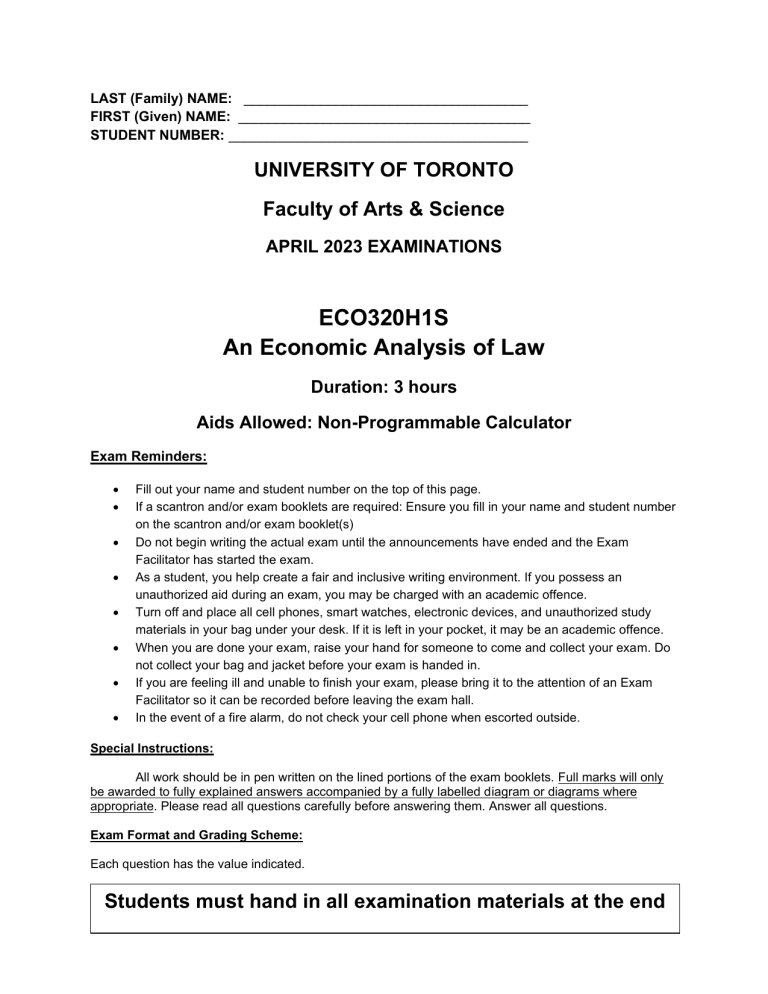
LAST (Family) NAME: _____________________________________ FIRST (Given) NAME: ______________________________________ STUDENT NUMBER: _______________________________________ UNIVERSITY OF TORONTO Faculty of Arts & Science APRIL 2023 EXAMINATIONS ECO320H1S An Economic Analysis of Law Duration: 3 hours Aids Allowed: Non-Programmable Calculator Exam Reminders: • • • • • • • • Fill out your name and student number on the top of this page. If a scantron and/or exam booklets are required: Ensure you fill in your name and student number on the scantron and/or exam booklet(s) Do not begin writing the actual exam until the announcements have ended and the Exam Facilitator has started the exam. As a student, you help create a fair and inclusive writing environment. If you possess an unauthorized aid during an exam, you may be charged with an academic offence. Turn off and place all cell phones, smart watches, electronic devices, and unauthorized study materials in your bag under your desk. If it is left in your pocket, it may be an academic offence. When you are done your exam, raise your hand for someone to come and collect your exam. Do not collect your bag and jacket before your exam is handed in. If you are feeling ill and unable to finish your exam, please bring it to the attention of an Exam Facilitator so it can be recorded before leaving the exam hall. In the event of a fire alarm, do not check your cell phone when escorted outside. Special Instructions: All work should be in pen written on the lined portions of the exam booklets. Full marks will only be awarded to fully explained answers accompanied by a fully labelled diagram or diagrams where appropriate. Please read all questions carefully before answering them. Answer all questions. Exam Format and Grading Scheme: Each question has the value indicated. Students must hand in all examination materials at the end Page 2 of 4 (10 Marks) QUESTION 1: Compare and contrast the Normative Hobbes Theorem with the Normative Coase Theorem and give one example for each theorem. Fully explain this comparison, paying close attention to the concepts of “efficiency” and “distribution”. (5 Marks) QUESTION 2: Explain the rule of capture and how it relates to the “tragedy of the commons”. Fully explain your answer using a diagram and one (1) example. (10 Marks) QUESTION 3: Explain the optimism bias and how it affects when claimants might start lawsuits and how it affects how claimants settle these lawsuits? (10 Marks) QUESTION 4: Explain the rule “buyer beware” in home buying contracts? Should it always apply? How does economic analysis determine the exceptions? (10 Marks) QUESTION 5: “The profit-maximizing firm will adjust safety until the cost of additional safety equals the benefit from reduced liability and higher consumer demand for the good.” Identify the model described in this statement. Draw a fully labelled diagram that includes identifying where the underlined concepts in the statement appear in your diagram. Explain the equilibrium that is contained in the statement. Please Turn to Page 3 Page 3 of 4 (10 Marks) QUESTION 6: According to one definition, a “nuisance suit” is a lawsuit that has no merit in the sense that the claimant’s EVT = 0. Which rule between “each pays his own” or “loser pays all” results in fewer nuisance suits? (10 Marks) QUESTION 7: Fully explain how private compensation for victims could be obtained from defendants in a plea bargain? Compare this with a tort claim for the same compensation where the joint and several liability rules apply. (5 Marks) QUESTION 8: Lawyers in large firms with recognizable law firm names can frequently charge higher than average hourly rates. Why? (10 Marks) QUESTION 9: A claimant C sues a defendant firm D for ten (10) million dollars for negligence. The evidence supports C having a 60% chance of winning and 40% of losing. C enters a contingent fee arrangement with her lawyer. That lawyer will receive 25% of what C receives at trial or settlement. D will pay its lawyer one (1) million dollars if the case settles before trial and two (2) million dollars if the case goes to trial. The Loser Pay rule applies. (a) (5 Marks) Fully explain the settlement between C and D that might arise before trial, calculating the threat points, scope for bargaining and the cooperative settlement surplus of C and D. (b) (5 Marks) If contrary to the evidence, C believes that C has a 40% chance of winning and 60% of losing, show how this falsely pessimistic bias of C affects the threat points, scope for bargaining and the cooperative settlement surplus you calculated in (a)? (5 Marks) QUESTION 10: The plaintiff who brings a suit to establish a more efficient precedent enjoys only a fraction of its social value. Does this fact show that the government should subsidize lawsuits by paying part of the cost of litigation? Please Turn to Page 4 Page 4 of 4 (10 Marks) QUESTION 11: (a) (5 marks) Is it possible to design and enforce a law so that only honest citizens have access to guns? (b) (5 marks) By using supply and demand graphs, show how decriminalization affects the supply and demand for guns? (5 Marks) QUESTION 12: A house built on a flood plain has a fair market value of $50,000. When a government plan to insure the house against floods applies, the fair market value of the house increases to $150,000. Now the government wants to expropriate the house in order to preserve the environmental quality of the flood plain. What is the socially efficient price the government should offer? $50,000? $150,000? Another price? Explain your answer. Total Marks = 100 End of Exam






